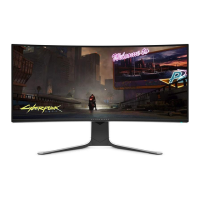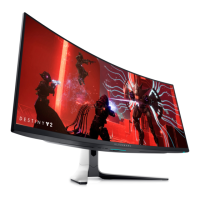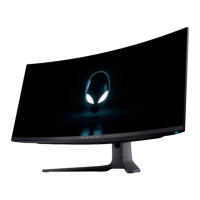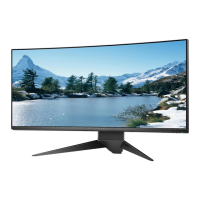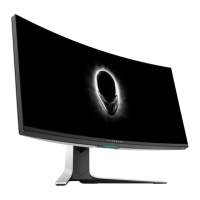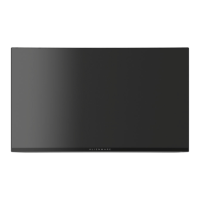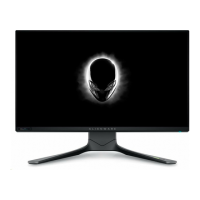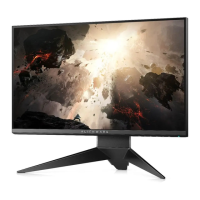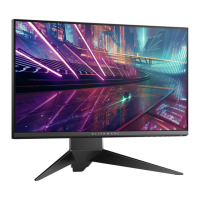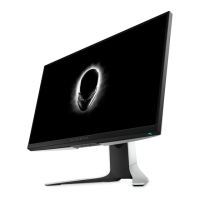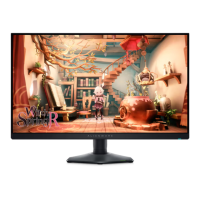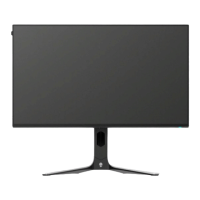Do you have a question about the Alienware AW3420DWb and is the answer not in the manual?
Defines the meaning of NOTE, CAUTION, and WARNING symbols used in the manual.
Lists all items included in the monitor package for unboxing and setup.
Details the monitor's key technical specifications, capabilities, and design highlights.
Identifies and describes the components visible on the front of the monitor.
Identifies and describes the ports and controls located on the rear of the monitor.
Details the specific ports and connectors found on the rear and bottom of the monitor.
Provides a comprehensive list of the AW3420DW monitor's technical specifications.
Lists supported resolutions, horizontal, and vertical scan ranges for the monitor.
Explains the available pre-configured display settings for various use cases.
Details the monitor's power requirements, input voltage, and current ratings.
Outlines the monitor's physical dimensions, weight, and stand adjustments.
Specifies operating and non-operating conditions like temperature, humidity, and altitude.
Explains how the monitor conserves power when not actively in use.
Details the pin configuration for the monitor's DisplayPort connection.
Describes how the monitor automatically configures itself with compatible computer systems.
Explains the monitor's USB ports, transfer speeds, and power delivery features.
Provides instructions for proper care and upkeep of the monitor.
Offers step-by-step instructions and precautions for cleaning the monitor.
Guides users through the physical assembly and connection of the monitor.
Provides detailed steps for assembling and securing the monitor stand.
Explains how to connect the monitor to a computer using video and USB cables.
Details the procedure for safely detaching the monitor's stand assembly.
Guides users on how to mount the monitor using a VESA-compatible wall bracket.
Simple instructions on how to turn the monitor on using the power button.
Explains how to navigate and use the monitor's joystick for OSD menu adjustments.
Describes the function and purpose of each button on the monitor's rear control panel.
Details how to access and navigate the monitor's main menu system for configuration.
Explains how to open and navigate through the monitor's On-Screen Display menus.
Describes how to select different pre-configured color and display modes for optimal viewing.
Explains features like Timer and Frame Rate to improve the gaming experience.
Details how to adjust the Dark Stabilizer for better visibility in dark gaming scenes.
Guides users on how to adjust the screen's brightness and contrast levels.
Explains how to select and switch between different video input signals (DP, HDMI).
Covers configuration of LED lighting effects across various zones on the monitor.
Manages audio settings, primarily for headphone output volume and resets.
Configures OSD display settings like language, transparency, and menu timer.
Allows customization of shortcut keys for quick access to frequently used features.
Accesses display info, firmware version, power saving, and factory reset options.
Displays messages related to power saving mode activation or factory reset confirmation.
Guides users on how to configure the monitor to its highest supported resolution.
Explains how to adjust the monitor's stand for optimal viewing angles and height.
Lists the necessary requirements for installing and using the AlienFX application.
Details the process of installing the Alienware Command Center through Windows updates.
Provides instructions for downloading and installing AWCC from Dell's official support website.
Explains the layout and features of the AlienFX control window for managing lighting.
Guides users through the process of creating and saving personalized lighting themes.
Describes how to configure various dynamic and static lighting effects for the monitor.
Explains the Morph lighting effect and its customization options for color transition.
Describes the Pulse lighting effect and how to adjust its speed and brightness.
Details how to set a single, static color for the monitor's lighting zones.
Explains the Spectrum lighting effect, which cycles through colors in a sequence.
Describes the Breathing lighting effect and its adjustment parameters for dimming/brightening.
Explains how to run the monitor's built-in self-test to diagnose display problems.
Guides on using the diagnostic tool to identify monitor vs. computer-related issues.
Lists typical issues encountered with the monitor and their corresponding solutions.
Addresses unique problems specific to the monitor's features and performance.
Solves common issues encountered with the monitor's USB interface functionality.
Highlights crucial safety precautions and warnings for using the monitor.
Provides regulatory compliance information and FCC notices for U.S. users.
Offers various methods to obtain technical support and assistance from Dell.
Defines the meaning of NOTE, CAUTION, and WARNING symbols used in the manual.
Lists all items included in the monitor package for unboxing and setup.
Details the monitor's key technical specifications, capabilities, and design highlights.
Identifies and describes the components visible on the front of the monitor.
Identifies and describes the ports and controls located on the rear of the monitor.
Details the specific ports and connectors found on the rear and bottom of the monitor.
Provides a comprehensive list of the AW3420DW monitor's technical specifications.
Lists supported resolutions, horizontal, and vertical scan ranges for the monitor.
Explains the available pre-configured display settings for various use cases.
Details the monitor's power requirements, input voltage, and current ratings.
Outlines the monitor's physical dimensions, weight, and stand adjustments.
Specifies operating and non-operating conditions like temperature, humidity, and altitude.
Explains how the monitor conserves power when not actively in use.
Details the pin configuration for the monitor's DisplayPort connection.
Describes how the monitor automatically configures itself with compatible computer systems.
Explains the monitor's USB ports, transfer speeds, and power delivery features.
Provides instructions for proper care and upkeep of the monitor.
Offers step-by-step instructions and precautions for cleaning the monitor.
Guides users through the physical assembly and connection of the monitor.
Provides detailed steps for assembling and securing the monitor stand.
Explains how to connect the monitor to a computer using video and USB cables.
Details the procedure for safely detaching the monitor's stand assembly.
Guides users on how to mount the monitor using a VESA-compatible wall bracket.
Simple instructions on how to turn the monitor on using the power button.
Explains how to navigate and use the monitor's joystick for OSD menu adjustments.
Describes the function and purpose of each button on the monitor's rear control panel.
Details how to access and navigate the monitor's main menu system for configuration.
Explains how to open and navigate through the monitor's On-Screen Display menus.
Describes how to select different pre-configured color and display modes for optimal viewing.
Explains features like Timer and Frame Rate to improve the gaming experience.
Details how to adjust the Dark Stabilizer for better visibility in dark gaming scenes.
Guides users on how to adjust the screen's brightness and contrast levels.
Explains how to select and switch between different video input signals (DP, HDMI).
Covers configuration of LED lighting effects across various zones on the monitor.
Manages audio settings, primarily for headphone output volume and resets.
Configures OSD display settings like language, transparency, and menu timer.
Allows customization of shortcut keys for quick access to frequently used features.
Accesses display info, firmware version, power saving, and factory reset options.
Displays messages related to power saving mode activation or factory reset confirmation.
Guides users on how to configure the monitor to its highest supported resolution.
Explains how to adjust the monitor's stand for optimal viewing angles and height.
Lists the necessary requirements for installing and using the AlienFX application.
Details the process of installing the Alienware Command Center through Windows updates.
Provides instructions for downloading and installing AWCC from Dell's official support website.
Explains the layout and features of the AlienFX control window for managing lighting.
Guides users through the process of creating and saving personalized lighting themes.
Describes how to configure various dynamic and static lighting effects for the monitor.
Explains the Morph lighting effect and its customization options for color transition.
Describes the Pulse lighting effect and how to adjust its speed and brightness.
Details how to set a single, static color for the monitor's lighting zones.
Explains the Spectrum lighting effect, which cycles through colors in a sequence.
Describes the Breathing lighting effect and its adjustment parameters for dimming/brightening.
Explains how to run the monitor's built-in self-test to diagnose display problems.
Guides on using the diagnostic tool to identify monitor vs. computer-related issues.
Lists typical issues encountered with the monitor and their corresponding solutions.
Addresses unique problems specific to the monitor's features and performance.
Solves common issues encountered with the monitor's USB interface functionality.
Highlights crucial safety precautions and warnings for using the monitor.
Provides regulatory compliance information and FCC notices for U.S. users.
Offers various methods to obtain technical support and assistance from Dell.
| Panel Type | IPS |
|---|---|
| Response Time | 2 ms (gray-to-gray) |
| Brightness | 350 cd/m² |
| Color Gamut | 98% DCI-P3 |
| Aspect Ratio | 21:9 |
| Curvature | 1900R |
| Resolution | 3440 x 1440 |
| Refresh Rate | 120Hz |
| Contrast Ratio | 1000:1 |
| G-Sync | Yes |
| VESA Mount | 100 x 100 mm |
| Viewing Angle | 178° (horizontal), 178° (vertical) |
| Connectivity | 1x DisplayPort 1.2, 1x HDMI 1.4, 4x USB 3.0 |
